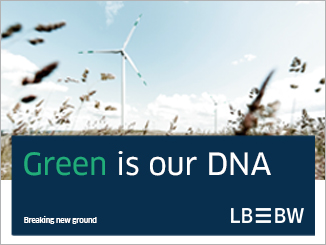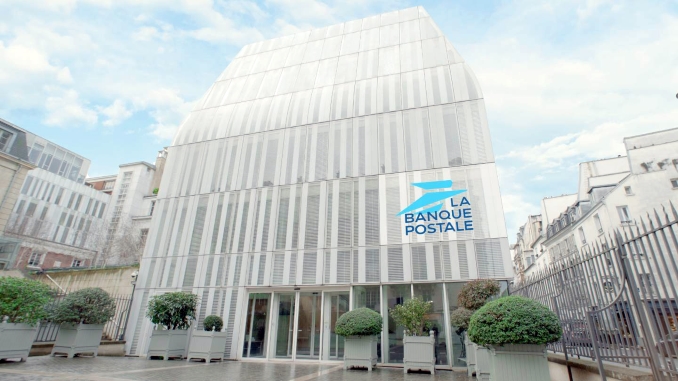
As the first European bank to have had its decarbonisation trajectory SBTi-validated and other pioneering steps, La Banque Postale can credibly claim to ’walk the talk’.
Sustainabonds’ Neil Day spoke to La Banque Postale’s Dominique Heckel, head of treasury, funding and repo, and Nicholas Vantreese, deputy chief sustainability officer, about its efforts to maintain an edge in ESG, and how its green and social bond offerings are evolving in light of market and regulatory developments.
You can download a pdf version of this article here.
Neil Day, Sustainabonds: In February La Banque Postale adopted the status of a “mission-led” company. What does it mean in practice about how you are steered and what you do?
Nicholas Vantreese, La Banque Postale: The fact that we’ve changed our status to become a mission-led company in February is a major landmark for us, but it is something that has been a long time coming. La Banque Postale was from the outset in 2006 created with a public service mission, to provide banking accessibility to populations that are the most in need, low income populations and fragile populations. So by definition, we have always been deeply connected to extra-financial issues — that was our original purpose, if you will. Thereafter, environmental issues became more and more important, with COP 21 in Paris in particular being a real booster for us, and we started to put a huge emphasis on the “E”, having already deeply covered the “S” aspect of ESG. The final element would then be the “G” to complete the trilogy and align our governance with our ambitions.
So becoming a mission-led company was the logical next step of our journey, to materialise very concretely our engagements so that they are now solidly and formally inscribed in our status. More than a beginning, it’s the pinnacle of a thought-out strategy that took us 15 years. Now that this change has been made fully official, it’s a driver for us to walk the next mile. Prior to last year, we already considered ourselves quite exemplary in our CSR approach, in our sustainable development philosophy, policies and the like. Just look at the extra-financial rating agencies: we ranked number one with basically all of them worldwide. So you could say that we had already done our job. But we are in a very competitive environment and have witnessed the entire industry moving towards greater sustainability, and if we wanted to maintain an edge, if we wanted to prove that we are something above and beyond a regular committed bank, then we had to go to the next level. Becoming mission-led was to us simply the demonstration that we were all about action and not just about words.
Day, Sustainabonds: Despite some evolutions in group structure and ownership, La Banque Postale remains rooted in the public sector. Meanwhile, you have taken control of CNP Assurances. How does the particular group ownership structure and background of La Banque Postale support it in making a difference in ESG terms?
Vantreese, LBP (pictured): I already referred to our original DNA with a public service mission, and we share that mission as a subsidiary of Groupe La Poste, which itself has four public service missions, banking accessibility being one that is passed along to La Banque Postale to manage. So, yes, our shareholder structure deeply influences us, with both La Poste and now Caisse des Dépôts having in common this mindset of working for the greater good. The fact that our shareholder structure has changed only strengthens our positioning. The acquisition of CNP wasn’t an accident, either, in the sense that we share common goals: we are committed to the same decarbonisation associations (NZBA for LBP, NZAOA for CNP), we both refer to the Science Based Targets initiative to validate our trajectories, both of our asset management arms have signed the Principles for Responsible Investment, we have both determined a plan to tackle the Sustainable Development Goals, and we are aligned in what we want to finance in terms of energy transition.
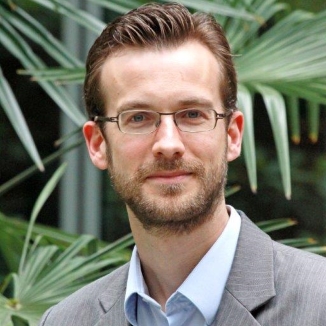
With CNP, we are now the 11th largest bank in the Eurozone in terms of size. And the fact that we are part of a larger group just puts some muscle behind us to make sure that we will be able to deliver on our commitments.
Day, Sustainabonds: You mentioned some of the things you’ve signed up to, but some of these announcements regarding GFANZ (Glasgow Financial Alliance for Net Zero) and the like have been met with a degree of scepticism, and everybody has their targets these days. How credible are your goals and are you engaged to a greater extent than others?
Vantreese, LBP: First, we didn’t wait for GFANZ or even the NZBA (Net-Zero Banking Alliance) to be established to formalise our own commitments towards net zero. Our commitment towards net zero was drafted one year before the NZBA was created, and in our commitment, we even decided on a deadline of 2040, 10 years ahead of the Paris agenda.
That being said, there is only so much we can do on our own — there’s no way we can decarbonize the entire world by ourselves! So it only makes sense to work in a collective fashion. Alongside UNEP FI and the Principles for Responsible Banking signatories, we lobbied to develop a bank working group around the net zero targets, to collectively address that challenge, and a year later, the PRB was launched. We are now on the steering committee of the NZBA to ensure that it goes in the right direction. La Banque Postale can only be accountable for its own actions, but it is our role to make sure that, as a group of banks, we walk the talk. Sometimes it works; sometimes we face technical discussions and have to compromise — but that’s the case for all multilateral institutions. At La Banque Postale, we made sure that our targets were science-based, which is why we worked alongside the Science Based Targets initiative, because we wanted our targets to be credible and certified by a very distinguished group of experts who developed those methodologies for the decarbonisation pathways of the finance industry. And if others now want to play along, then all the better, because we believe that it has to be a group effort. Our role is to be exemplary, to show that it’s feasible and thereby demonstrate that others could do it, too, if they put the effort into it.
One final point is that as of last Monday, we validated a new internal price for carbon: €60 for every tonne of CO2 that we emit. We are one of the few leading financial institutions to have set up such a high internal carbon price. And it’s a real internal price; it’s not shadow pricing — it’s something that really has an impact on our books. With that internal carbon tax, we will finance energy efficiency projects, CO2 compensation and sequestration projects, biodiversity projects, as well as major improvement works in our buildings. You can take that as a demonstration that we mean business.
Scope 3 category 15 indirect GHG emissions (investments)
85% of total loans and investments covered by SBTi methodology*

*Note: excludes short and medium term loans, long term loans to unlisted companies, unlisted corporate bonds, sovereign bonds, consumer finance, loans to the local public sector/authorities; Source: La Banque Postale
Day, Sustainabonds: You’ve highlighted accessibility as being part of your original missions. Can you give some examples of what this means in practice in terms of supporting people?
Vantreese, LBP: Indeed, that was the very first topic that we addressed in our CSR journey, in that it was one of the reasons La Banque Postale was originally founded — there were certainly already enough players in the French banking landscape, but none that addressed financial inclusion so thoroughly into its business strategy.
We initially created a group, an action-tank comprised of French associations aimed at tackling financial exclusion. Along with the original dozen or so members, we worked on how to fight financial exclusion and work in favour of banking accessibility. That led us, for example, to develop a platform called l’Appui with telephone counsellors who have no commercial objective but are there to listen to and to advise clients in borderline financial situations. We can give them the appropriate counselling to ensure they do not fall into over-indebtedness, that they budget appropriately, and that they can benefit from public support that they are not always aware of. That was one of the main outcomes of the action-tank. Today we have on-boarded more than 20 associations and they are still brainstorming with us to help those populations in need. In terms of client base, we have 1.4m clients who benefit from the specific products we have developed to fulfil our public mission, and over 1.5m clients who are in a fragile financial situation, so overall close to 3m citizens for whom La Banque Postale provides a very unique and distinctive role in helping them keep their head above water financially — that accounts for 40% of the financially underprivileged population in France.
Day, Sustainabonds: As you put it earlier, that deals with what you are doing in regards to the “S” in ESG. Moving onto the “E”, what are you doing to help and incentivise your various clients — from retail banking to the new CIB — to become more sustainable and move towards net zero?
Vantreese, LBP: There are many aspects depending on what type of clients we’re talking about.
Let’s start with retail customers. We started with green loans, which were launched around COP 15, to help finance home improvement works or to acquire low emission vehicles. A couple of years ago, those consumer loans were transformed into impact loans. Now, for every loan that is used to buy a vehicle, whatever the type, we help the customer mitigate the negative impact by compensating the CO2 emissions through the lifespan of the credit, free of charge for the customer — of course, if it’s an electric or hybrid vehicle, preferential rates are available. That’s one example of how we’ve introduced the notion of positive impact, or at least negative impact mitigation, within our product ranges. We are now working on a savings account formula that we want to switch into an impact formula, alongside impact real estate loans that we’re developing based on a proprietary tool. We call this the “impact weighting factor”, which will help us, based on the environmental, social and territorial aspect of a loan, to offer a preferential interest rate if it has a positive impact. So those are examples of the innovations we’re working on.
We will also be using that impact weighting factor in the CIB area to analyse every transaction and every client we are providing financial services to, to measure La Banque Postale’s environmental impact, but also the social and territorial impact, and we hope that will help us steer our portfolio in the right direction. In terms of products, we have of course launched impact loans, green loans totally aligned with the Taxonomy, and we have been able to refinance those green loans in our green bond programme.
So the environmental aspect of our positioning is gathering pace nowadays.
Of course, while it’s good to demonstrate that we are having a positive impact, I must also mention that we don’t want to have a negative impact, either. That’s one of the reasons we have announced that we want to divest completely from the oil and gas industry. We are one of the first financial institutions worldwide to have come up with such a commitment, to be totally exited from the fossil fuel industry by 2030.
Culture of environmental, social and regional impact through LBP products and services
Products and services are designed with an ESG checklist in association with Utopies and WWF
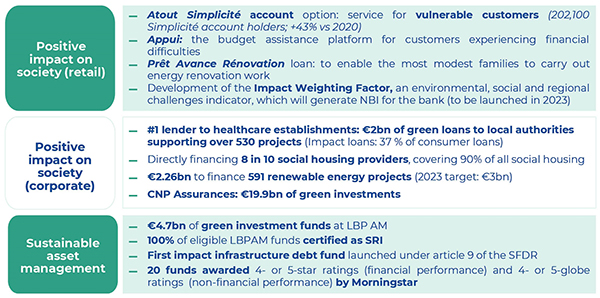
Source: La Banque Postale
Day, Sustainabonds: Turning to your framework, arguably where your mission connects with the bond market, how does that reflect your ESG activity?
Vantreese, LBP: We drafted that framework in 2019, which perhaps doesn’t seem like so long ago, but in the field of sustainable finance, it’s an eternity. At that time, there was no green Taxonomy, the social Taxonomy wasn’t even on the table. So we had to figure out for ourselves the assets that we would be able to refinance in a green or social framework, and that would seem credible to the market, so we tried to identify internally those assets whose credentials would leave no room for doubt — who, for example, can argue about financing renewable energy projects? We were always striving for the highest standards. The same for real estate, whether commercial or residential: we sought the best energy standards. Our purpose was to have a framework that would be best in class. As for the social categories, because we are the lead banker for the public sector, for public healthcare institutions, and for social housing, those were obvious asset classes that we felt very comfortable writing into our framework. Our inaugural bond in 2019 was very well accepted by the market because it was based on La Banque Postale’s extra-financial performance and an asset category that could only be considered green, being solely renewable energy. We then issued a social bond based on access to essential services, healthcare, and affordable housing, which was also straightforward for investors. And more recently we have issued another green bond, based on real estate.
The main challenge now will be to update that framework to make sure that it is as aligned as possible with the green Taxonomy — we will look for 100% alignment, but we still have some work to do to make sure that is feasible, and if it is not, then we will be fully transparent about it. That’s keeping us busy right now, because we want to make sure that for every green category in the Taxonomy we have the right thresholds and the right accounting methods internally to make sure that we’re able to trace those assets. Regarding real estate, for example, it’s quite complicated for both practical and technical reasons. Our IT systems were not built in a way that allows us to trace the energy performance of the households we finance. We’ve changed that, but there’s still some work to be done, because we lack historic data. And we have yet to determine what, based on the Taxonomy, could be considered fully aligned. RE 2020, the new French energy regulations for new-builds, are already quite demanding, but the EU Taxonomy asks us to go 10% beyond the highest national standard. Having to go 10% beyond whatever is already very demanding means that it may be hard for us to find enough assets to finance in a green framework. That’s the kind of challenge we’re going to face if we want to be fully aligned.
Dominique Heckel, La Banque Postale: And even if we will definitely have some financings of new buildings that we believe are eligible for the Taxonomy, we then have to prove it. That’s the main issue: it’s not just about collecting the level of energy performance, but about the primary energy consumption level of the house. So you will need to collect those data and store them in your IT system.
Vantreese, LBP: Indeed, you have to demonstrate the impact by publishing an impact report, and how do you demonstrate the positive impact for all of those different kinds of dwellings over time?
Regarding our update to the framework, we will also be rearranging the way we present the overall structure of asset classes to reflect the Taxonomy. We have tended to organise these in terms of product ranges, but now they will be more aligned with the green Taxonomy nomenclature. And the same for the social aspects — although the social Taxonomy is at a very early stage, we at least know the main categories there might be.
And of course in 2019 we hadn’t yet adopted the mission-led status, and that will have an impact on the introductory part of the framework about the company’s purpose and CSR approach. So it’s a complete overhaul of the document.
Day, Sustainabonds: The impact real estate loans that you mentioned, are they something that could play a role in green covered bonds going forward?
Vantreese, LBP: Maybe. If everything goes according to plan, these impact real estate loans will be launched by the beginning of next year. It will take some time to market the product and build up enough assets to even consider refinancing those assets within the framework. So time will tell. It’s not out of the question — particularly given that we will have worked to ensure that the quality of data and the impact measurement methodologies — including our impact weighting factor — are sufficient if we do decide to add them to the eligible assets.
Day, Sustainabonds: As you mentioned, the social Taxonomy is still at a fairly early stage, but what do you make of the proposals so far? Could it be a help, or is social different to green when it comes to a Taxonomy?
Vantreese, LBP: We shouldn’t forget that even in the green Taxonomy, if you put together the do-no-significant-harm criteria and the social safeguards, the social aspect was somehow already present. What the social Taxonomy per se will add is some clarity on the social technical criteria and harmonized presentation guidelines. We’ve already made a first attempt at coming up with the major categories, but all the better if everyone can now speak a common language.
Inaugural social bond issued in June 2021: transaction porfolio*
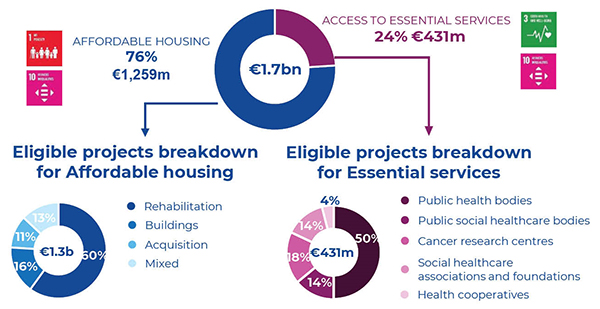
*Note: breakdowns presented based on the financing granted; Source: La Banque Postale
Day, Sustainabonds: Turning to your issuance under the framework, as you alluded to, La Banque Postale issued its first green covered bond in May. This came amid challenging market conditions — what was the reason for the timing, and how did the outcome compare with expectations?
Heckel, La Banque Postale: We are committed to being a regular issuer in terms of green and/or social issuance, and so it was kind of a given that we would eventually come to the market with a green covered bond — it was just a matter of finding the right window of opportunity. And after having been away from the primary covered bond market for more than two years, we really wanted to demonstrate a spectacular return with this first green covered bond issuance. The timing was guided by the result of the French presidential election, and the desire to avoid too much noise coming from discussions around ECB rate hikes and the end of the Asset Purchase Programme. The result was quite fantastic, with a large, granular and top quality order book, and around 66% of the allocation given to investors integrating ESG criteria in their investment process. We therefore successfully seized the opportunity to reach a large covered bond investor base in a very challenging market environment, which combined the war in Ukraine, deflationary pressures around the globe, rising yields, and the central bank response. So overall, we were quite satisfied with that transaction.
Day, Sustainabonds: You have now issued in green and social, and in secured and unsecured formats. Admittedly, these have been launched into quite different market environments, but have you found any particular pros and cons of the different formats, when it comes to distribution or pricing, for example?
Heckel, La Banque Postale (pictured): Indeed, before the green covered bond, we issued green and social non-preferred, as senior non-preferred issuance constitutes the core of the funding plan of La Banque Postale. Given the various crises that we have faced in the last couple of years, we have plenty of liquidity, which explains why we have been issuing a bit less in covered bonds.
 Both covered bonds and senior non-preferred — and senior preferred, even if we are not really active there for the moment — now have a very large investor base whatever the theme, social or green. But the more you go down the capital structure, the more significant the greenium becomes. In the case of covered bonds, we managed to price our inaugural green issue through the fair value of regular covered bonds — at the time, the new issue premium for regular covered bonds was 2bp-3bp, so by pricing through fair value we had a greenium of around 3bp. For senior non-preferred, it’s more in the region of 5bp-6bp. But then it’s always a question of market conditions, supply and demand, so things can move.
Both covered bonds and senior non-preferred — and senior preferred, even if we are not really active there for the moment — now have a very large investor base whatever the theme, social or green. But the more you go down the capital structure, the more significant the greenium becomes. In the case of covered bonds, we managed to price our inaugural green issue through the fair value of regular covered bonds — at the time, the new issue premium for regular covered bonds was 2bp-3bp, so by pricing through fair value we had a greenium of around 3bp. For senior non-preferred, it’s more in the region of 5bp-6bp. But then it’s always a question of market conditions, supply and demand, so things can move.
What is definitely very positive is the diversification that you get with these formats. You get larger orders from some accounts, others only participate because it’s green, or because they are very happy with the ESG credentials of the issuer — we also see that more and more investors are putting a big focus at the issuer level, not only on the asset level. So it’s something that is valuable in order for issuers to get more diversification. The greenium is fine, but it’s not the only objective for us. I recall some panel discussions on green covered, where a lot of issuers were saying, no, I will not issue a green covered because there is more value in keeping these assets for issuing senior non-preferred debt or whatever, even Tier 2 now — we have seen more and more Tier 2 issuance in themed formats. But we really want to be active across the full spectrum of our funding programme. Covered bonds is one of the pillars of this — in recent years we had lower needs, but I hope that it will be a bit more the case in the future. And so going forward, we will consider being as active as possible. And why not Tier 2? The investor base there is now getting a bit more used to seeing this kind of issuance from the banking sector. It’s a dated bond with a must-pay coupon, so there is no problem around the structure. I would say that for AT1, it’s a bit of a different story, because firstly, it’s a perpetual bond, and the purpose for which the AT1s are built may not be suitable for investors who might be hurt by activities that are not necessarily green. That could be an issue and we like to be very straightforward, so we don’t want to get into this grey area.
Day, Sustainabonds: Picking up on what you mentioned about the issuer as much as the assets being a focus for many investors, that’s something sustainability-linked bonds might be aligned with. I know that banks face issues regarding the EBA’s problems with SLBs, but could you conceive of SLB issuance in future?
Heckel, La Banque Postale: Banks tend to be more focused on a portfolio approach and issuing to refinance this portfolio, so the use-of-proceeds approach is more suitable for banks, unlike corporates, for whom SLBs may be appropriate. I would for the moment recommend La Banque Postale to maintain a use-of-proceeds approach, and not necessarily follow the route of SLB issuance — although we should never say never.
Day, Sustainabonds: To conclude, how would you sum up what we can expect to see from La Banque Postale going forward?
Vantreese, LBP: Following the landmark change in our status, we will now work on offering more and more proof that we are indeed quite serious about developing a position of leadership in terms of sustainability, alongside La Banque Postale’s new strategy up to 2030. A sustainability team has been created that now reports directly to the president of La Banque Postale and sits at the executive committee level. Looking at these initiatives, at the different markets we have tapped, the product range that we have launched, and our issuance programme, it is no longer accurate to say that there is a sustainability strategy and there is a corporate strategy — they are two sides of the same coin. Our leitmotif now will be to constantly demonstrate the return on investment of an efficient sustainability strategy. That’s basically my job: to make sure that we’re not seen as a cost centre; on the contrary, we bring benefits to the company, tangible benefits, by developing the right products that meet the market’s needs and our investor base’s expectations.
Sustainabonds conducts all research and writing independently to maintain the full editorial integrity of the publication.
As a supporter of Sustainabonds, LBBW is facilitating a series of interviews with leading players in ESG and the green, social and sustainability bond markets.

